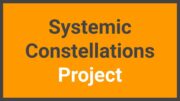
Introduction
Benefits
5 Steps
Introduction
In transformative processes, you often have the frustrating feeling that you know what you want to leave behind but not where you want to go instead. Constellation work exposes you to a glimpse of what a system in a potentially improved future could look and feel like. This process can be very motivating and provide valuable orientation. Since systemic constellations can be experienced by several people at the same time, they can even contribute to the emergence of coherent collective visions and goals. Systemic constellation work applies to a wide variety of fields: especially psychotherapy and self-development (e.g. ‘family constellations’) and consulting for organisations (e.g. ‘organisational constellations’). Several scientific studies have empirically validated the usefulness of constellations.
Benefits
Constellations are a powerful tool to:
- Resolve your problems by identifying the underlying issues
- Unleash your creativity, get new ideas, see things from a fresh perspective
- Gain a deeper understanding of the stakeholders you are involved with
- Implement fruitful and lasting organisational structures, cultures and goals
- Sharpen your intuition and perception skills
A particular benefit of constellation work is its time efficiency. Three hours are usually enough to gain in-depth insights into an issue and to develop possible strategies for a solution, including concrete next steps.
5 Steps
Constellation work can be done one-on-one and in groups. To give you an idea of a constellation here is an example of the steps taken during an organisational constellation workshop:
1. Issue Describing the issue which the case giver wants to address
Together with the facilitator, the case giver identifies the most important elements that compose the relevant system for the issue. These elements can be individuals and organisations, non-human life (e.g. animals, plants), objects (e.g. buildings, products) or abstract entities (e.g. feelings, goals).
2. Visualisation Representing the elements by the workshop participants
Representing an element means embodying it. The participants’ positioning in the room (which they may decide on themselves or be directed by others) reflects their embodiment of respective elements. In this way, structures, relationships and dynamics are visualized.
3. Perception Tuning into a mindful perception of the situation
Accompanied by the facilitator, the representatives tune into a mindful perception of the situation, their intuitions and their bodily sensations and then express their observations and feelings. They can change position in the room when they feel the need to do so. Step by step, the constellation moves towards a more harmonious state. The participants who are not serving as representatives mindfully observe the process.
4. Disembodiment Stepping out of the roles
When the facilitator decides to end the constellation, the participants who were representatives step out of their roles.
5. Harvest Harvesting of impressions, insights and implications
Finally, a harvesting process can be facilitated where all participants can share their impressions of the constellation process, their insights and its implications for the real-life situation.

